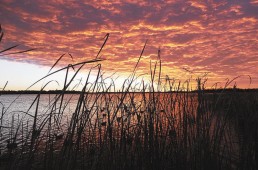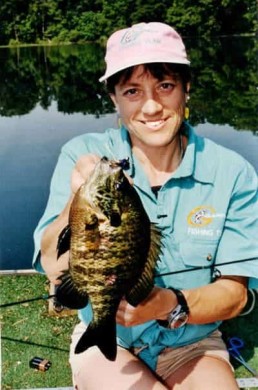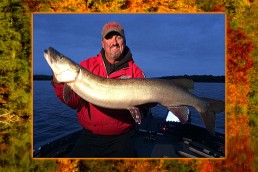Mixed-bag Bounty of Surf and Turf on a Fall Float
SHARE THIS POST
The aging old owl gazed down as a small jon boat slipped past. Its two occupants passed slowly beneath her. She blinked and refocused her gaze at a spot where a field mouse had disappeared. Intrusion of the anglers had robbed the old gal of a meal. But she knew the nervous little critter would soon reappear. Thus, its demise was assured.
It was early morning on Sucker Creek. The anglers, a man, and his lady friend had come to float the small winding stream to hunt gray squirrels to provide a dinner stew. To enhance this meal, a few filets of panfish such as rock bass would also be sought.
Sucker Creek, its name changed to protect it, lay on the border of Iowa and Missouri. It would travel through miles of wooded farmland and had only county road accesses by which the hunter/angler could get into it. These anglers had found a way. By dropping their jon in off county road E, and floating the six miles to county road J, the game treasures along this creek would be harvested. A more detailed explanation of how this is done is told later in my column.
It was an October morning during the archery deer season. Hardwood leaves had turned yellow and orange along the stream corridor. A fresh northern breeze had brought a hint of frost two days ago. The lady held a scoped .22 automatic rifle, as well as a 5 1/2 light-spinning rod and the man, a 20-gauge shotgun and a similar spinning outfit. The day was sunny and hopes for a successful float ran high. They’d done this a week before during the early duck season when three wood ducks, a mallard and seven rock bass had been collected.
Much to their surprise, three catfish had also fallen victim to their spinnered artificial lures. The lure was a 1/16-ounce Spin Bee, deadly on the creek’s panfish. On the end of that trip, the lady’s prized lure had been lost when an odd occupant of the creek—a largemouth bass—wrapped itself around the roots of a fallen tree and broke off. She would purchase several more at a local sports shop in preparation for this trip.
The day I describe in this column is one many river runners will experience during summer and fall. It can be extremely fruitful and easily done in 90 percent of small streams across North America. However, there are certain rules to follow. Here are some tips to help the first timer:
Equipment guide: a small 10- to 14-foot jon boat with or without an electric motor. Paddles or oars will work. Depending on stream depth, a 2- to 4-hp outboard motor can be used. A canoe will work for energetic folks.
Hunting gear should include a scoped .22 rifle for squirrels or a small-gauge shotgun if waterfowl or grouse season is on. Jump-shooting waterfowl on any of these creeks often provides excellent results.
Fishing gear must be fitted to the species you seek. I prefer a 5 1/2-foot lite-spinning rod, loaded with 8-pound-test monofilament line. Why 8-pound mono? In running water or dingy creek water, an 8-pound line is diminished in visibility and will be strong enough to pull off 50 percent of snags you encounter. Lighter 4- or 6-pound-test will break on hang-ups and your tackle box will diminish fast of its lure contents.
A Special Tip: Carry an 8-foot wooden pole along to jam into the bottom to stop your boat once a squirrel has been shot and dropped. It’s easy to lose sight of your harvest if it bounces off leaf-covered ground if your watercraft continues to travel downstream. The same pole is used to stop boat progress as fish are caught from a bank hole. The person in the watercraft’s rear stops the boat.
Are you enjoying this post?
You can be among the first to get the latest info on where to go, what to use and how to use it!
One block into their float, the male occupant rammed the wood pole into the sand bottom to stop the jon. Pointing up to a tall hickory on the right, he’d spotted a squirrel. A moment passed as the lady readied her rifle. Moments later a gray head appeared and was met with a shot from her 22. Later, two more squirrels would fall, enough to fill a Monday night stew pot.
As the lady retrieved her prize, enough time was allowed for her companion to cast a lure into a bank eddy just downstream from where they held. Instantly, a fat rock bass hit his Spin Bee. As the lady stepped back into the jon, a second rock bass was gathered. During the balance of this float, several more rock bass and four bluegills came to the boat. These would fill the needs of a Friday night fish fry.
Floats such as this can be better accomplished if certain methods are followed. Here are the main ones:
No. 1: Two vehicles should be used. One is left off at the downstream exit point. Then the watercraft-carrying vehicle drops the boat or canoe off at the entry point. Once the float is completed you use the downstream vehicle to retrieve the one up above.
No 2: By obtaining a county road map, you are able to plan your float better. Allow approximately one hour of float time for every mile of travel.
No 3: Trees may be blown down across the stream you float, so be prepared to do some portaging. You may get wet. One of the participants should wear hip boots.
No 4: With this in mind, watercraft weight and size should be a consideration.
The float this day was six miles in length, but it took the two participants nine hours to complete. Waiting out cautious gray and fox squirrels added time to the trip. But the adventure was worth it—and always is. It’s an outing that can take an angler back in time and provide a somewhat wilderness outing in a world filled with traffic and modern day hassles.
Until next time, this is “Bobber” Anne hoping my readers relax, savor and enjoy the great outdoors, as the Ol’ Man always says.
MWO
SHARE THIS POST
Did you enjoy this post?
You can be among the first to get the latest info on where to go, what to use and how to use it!
Dan Gapen
Considered one of the world’s leading river anglers, Dan Gapen, Sr. has shared his knowledge with MidWest Outdoors readers and viewers for more than 40 years. He is a member of all three Fishing Halls of Fame—International, National Freshwater, and Minnesota. He has an immense grasp of the world’s fisheries. He may be contacted at 877-623-2099.
@TheGapenCompany.




